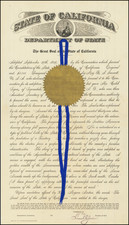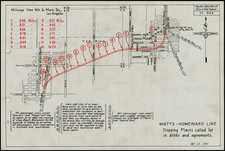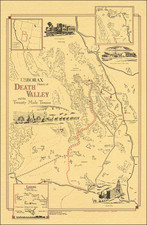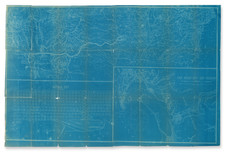Finely executed official survey of Rancho Cañada de Pogolimi, as undertaken by John Lacroze, U.S. Deputy Surveyor, for Antonia Carzares. The original survey is dated September 26, 1854, with this copy signed by John C. Hays and dated the following day, September 27, 1854.
The map is annotated with additional information including the names of over a dozen early land owners and roads and other early information in several different hands. Some of the pioneer names shown include:
- Isaac Kuffel
- Henry Hall
- John McReynolds
- Jacob McReynolds
- Elliott Cofer
- C. Steward
- Jos. Gordon
- Robert Bailey
- E. Hickman
- James Carroll
- Jas.Finley
- Other early names appear in pencil
The map appears to have pencil notes reflecting the results of later surveys and subdivisions of the land.
A school house and some other structures are shown, along with the Roads to Petaluma and San Rafael and an unnamed road at the west end of the map.
Rancho Cañada de Pogolimi
Rancho Cañada de Pogolimi (also called "Cañada de Pogolome" and "Cañada de Pogolomi") was an 8,800 acre Mexican land grant in present-day Sonoma County, California given in 1844 by Governor Manuel Micheltorena to María Antonia Cazares, widow of James Dawson.
At the direction of Governor José Figueroa in 1835, Mariano Guadalupe Vallejo began construction of the Presidio of Sonoma to counter the Russian presence at Fort Ross. To extend the settlements in the direction of Fort Ross, Vallejo sent three men, Edward McIntosh, James Black (1810–1870), and James Dawson, west toward the Russian settmeent. Black settled upon what is now known as Rancho Cañada de Jonive, while Dawson and McIntosh settled upon Rancho Estero Americano. They formed a partnership to build a saw-mill on Salmon Creek, near the town of Freestone. The Russian-American Company left Fort Ross and sold it to John Sutter in 1841. The mill on Rancho Cañada de Jonive operated until 1849, when they sold all the lumber they had and left for the gold mines.
McIntosh and Dawson agreed to make application jointly to the Mexican government for the two square league grant known as the Rancho Estero Americano, to confirm the title given them by General Vallejo. McIntosh went the capital in Monterey to get the necessary papers in 1839. However at that time, the Mexican authorities did not like making grants to multiple owners. When McIntosh returned, Dawson on examining the papers, found that they were made out only in the name of McIntosh.
In June 1840, James Dawson married 14-year-old María Antonia Cazares. Dawson continued to reside on his rancho with his wife until his death in October 1843. The Rancho Cañada de Pogolimi grant was made to his widow, María Antonia Cazares (1826–1880) in February 1844.
María Antonia Cazares de Dawson married Frederick Gustavus Blume (1815–1890), a Sonoma, California physician, surgeon and merchant, in November 1847. Blume was born in Bautzen, Kingdom of Saxony in 1815, and first traveled to California in late 1842. From Sonoma, Blume put his brother-in-law Henry Hagler in charge of his wife's rancho for the winter. The Blumes moved from Sonoma to live on the rancho in 1848, on a prominence overlooking the town of Freestone.
The town of Bloomfield, located on the rancho, was named in honor of Blume.
With the cession of California to the United States following the Mexican-American War, the 1848 Treaty of Guadalupe Hidalgo provided that the land grants would be honored. As required by the Land Act of 1851, a claim for Rancho Cañada de Pogolimi was filed with the Public Land Commission in 1852, and the grant was formally patented to María Antonia Cazares in 1858, 4 years after this survey was completed.
John Coffee "Jack" Hays was a captain in the Texas Rangers and a military officer of the Republic of Texas. Hays served in several armed conflicts from 1836 to 1848, including against the Comanche people in Texas and during the Mexican–American War. With the Gold Rush, Hays relocated to California, becoming a successful real estate investor and rancher, before serving in the Civil War.
In 1836, Jack Hays migrated to the Republic of Texas. Sam Houston appointed him as a member of a company of Texas Rangers because he knew the Hays family from his Tennessee years. Jack met with Houston and delivered a letter of recommendation from then-President Andrew Jackson his great uncle.
Hays would go on to lead the Rangers on a campaign against the Comanche in Texas. Jack rode with an Apache Chief named Flacco who led the charge into every battle with him. In 1840 Tonkawa Chief Placido and 13 scouts joined with the Rangers to track down a large Comanche war party, culminating at the Battle of Plum Creek.
Later, Hays commanded a Ranger force against the invasion from Mexico of 1842. During the Mexican–American War (1846–1848), Hays commanded the First Regiment of Texas Rangers at the Battle of Monterrey and led forces along the Texas border. He then commanded the Second Regiment of Texas Rangers in Winfield Scott's Mexico City campaign.
In 1849, Hays was appointed by the United States government as the US Indian agent for the Gila River country in New Mexico and Arizona. The same year the Hays led a party of Forty Niners from New York that traveled in wagons to California from Texas. This party pioneered a shortcut on Cooke's Wagon Road that saved a long journey to the south. That improved route became known as the Tucson Cutoff.
Hays was elected sheriff of San Francisco County in 1850, and later became active in politics. In 1853, he was appointed US surveyor-general for California.
Hays was one of the earliest residents of the city of Oakland. In the following years, he amassed a considerable fortune through real estate and ranching enterprises. In 1860, while in Virginia City, Nevada, on business, he heard the news of the First Battle of Pyramid Lake. He commanded a force of volunteer soldiers at the Second Battle of Pyramid Lake.
In 1876, Hays was elected as a delegate to the Democratic Party national convention, which nominated Samuel J. Tilden for the presidency of the United States.









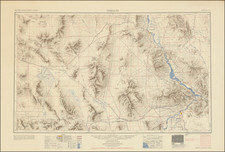
![[WWII War Bonds] As](https://storage.googleapis.com/raremaps/img/small/63461.jpg)
